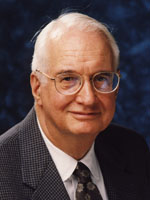
Ralph Hirschmann
University of Pennsylvania
From The Cortisone Era To The Peptide Age
It is a pleasure and a privilege to reminisce about the August 1953 Chemistry of Steroids and Related Natural Products Gordon Conference on the campus of the New Hampton School in New Hampton, New Hampshire, and the first Chemistry and Biology of Peptides Gordon Research Conference at the Miramar Hotel in Santa Barbara, California, in January 1976. These conferences differed from each other as much as New Hampton differs from Santa Barbara. What they had in common is that both were unforgettable events.
April 1948 marked the beginning of what I call the “cortisone era.” That month Merck had shipped a sample of cortisone, prepared from cholic acid, to Philip Hench and Edward Kendall at the Mayo Clinic, who carried out a clinical trial to determine the effects of the two endogenous glucocorticoids–cortisone and its equilibrium partner in vivo, cortisol–on patients suffering from rheumatoid arthritis. The results showed that both hormones produced dramatic anti-inflammatory effects. These historical medical events had followed earlier chemical breakthroughs that resulted in the isolation of cortisone by Kendall and Tadeus Reichstein and the subsequent thirty-seven-step partial synthesis of the hormone by Lewis Sarett and Max Tishler at Merck.
The momentum of steroid research at the time of the 1953 Steroids Conference was the result of fierce competition among many of the world’s leading bioorganic chemists who had become deeply involved in the research. Conference speakers included Derek Barton, Ian Bush, Louis Fieser, Josef Fried, Oskar Jeger, William Summer Johnson, Ewart Jones, R. Norman Jones, Durey Peterson, George Rosenkranz, Sarett, Franz Sondheimer, Norman Wendler, Robert Woodward, and other organic chemistry greats.
Even the sense of congeniality that prevailed throughout the 1953 conference could not hide a sense of nervous tension, as each attendee wondered which of the renowned speakers might have outdone him. No scientific meeting that I attended during the subsequent fifty years could compare to that Gordon Conference. This conference was also unforgettable for me because the late Dr. Wendler, an outstanding organic chemist and my boss at the time, spoke about steroid C/D ring transformations, describing my first communication to the editor of the
Journal of the American Chemical Society in 1952 in which I reported on the C-nor-D-homo rearrangement and coined the term
stereoelectronic control.
Toward the end of the 1950s steroid research had peaked, but in the 1970s peptide research was greatly stimulated by growing excitement about recently reported research on peptide biology and chemistry and indirectly by news of the first total synthesis of an enzyme (ribonuclease). The latter landmark chemical event was reported in January 1969 by Robert Merrifield and Bernard Gutte of Rockefeller University and by the Merck group headed by Robert Denkewalter, my boss, and our collaborators.
William Gibbons chaired the first Gordon Conference on the Chemistry and Biology of Peptides in 1976. The Peptides Conference differed from the Steroid Conference in that the number of biologically active endogenous peptides of great importance to physiology and medicine exceeds that of the physiologically significant steroids, making peptides a very appropriate subject for Gordon Conferences. However, the intensity of the Steroids Conference in the early 1950s will remain hard to match.
Because of the intimate atmosphere that is the hallmark of all Gordon Research Conferences, taken together, the Steroids and Peptides Gordon Conferences will remain memorable for all who were privileged to attend them.